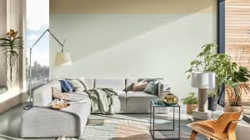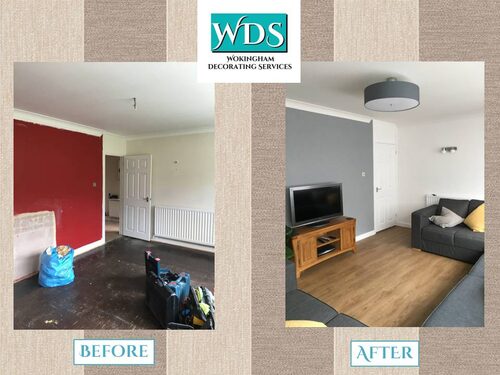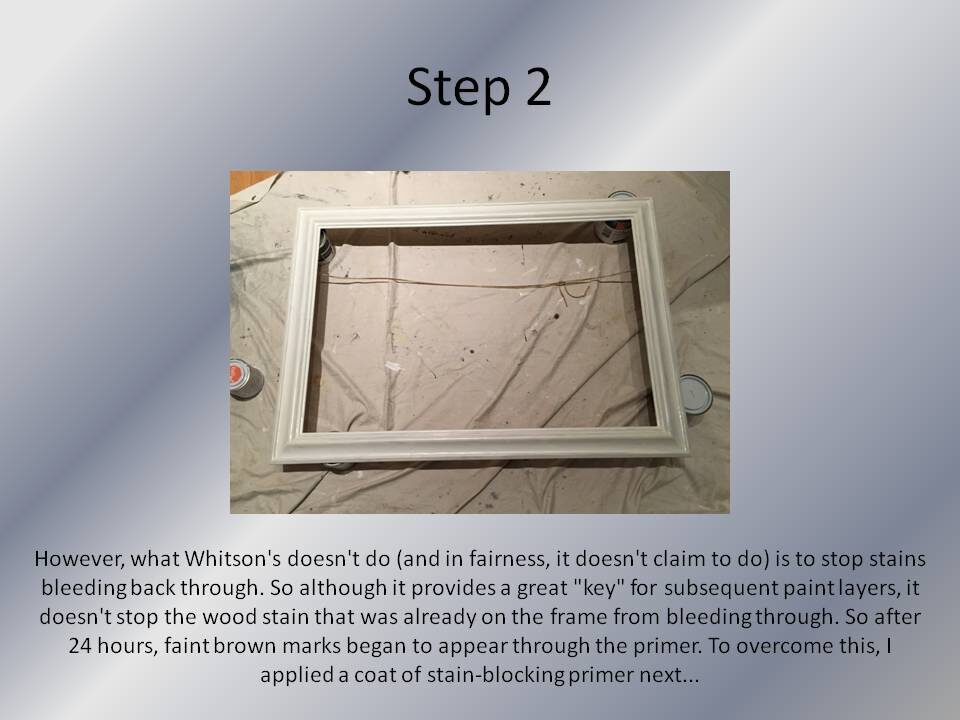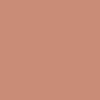It's probably fair to say that 2020 was a bit of a strange year. Speaking personally, I went from being busy, to having two months off completely, to being really busy again, and then having to stop work early just before Christmas due to the virus. But there was a lot to be thankful for - myself and my family managed to stay fit and healthy, I met a lot of lovely new customers, and was fortunate enough to be on the receiving end of some very complimentary online reviews. So it wasn't all bad.
But as I take a slightly extended (who knows? Maybe it will be very extended!) Christmas break, it gives me the chance to put virtual pen to cyber paper once more and create one of my very infrequent blog posts. So it's time to look forward now to 2021 and take a look at where the trends in decorating are heading. This year, as well as all the manufacturers' (often contradictory) contributions with their colours-of-the-year, I'm also going to throw in some of my own personal thoughts, and also share some of what I've seen on various decorators' forums (so a "real time barometer" of what real decorators are actually doing out there in the real world).
I'll start with the usual caveat though - there are no "right" or "wrong" answers to the "how should I decorate my living room?" question. Every room is different in its shape, its layout, its furnishings, how it is used, the lighting, and so on, so there can't be hard-and-fast rules that work for every room. And so much of it is down to personal taste, and you as the customer are the one who will be living in (and hopefully enjoying) the room for years to come, so the most important thing is that you like it, regardless of what other people think or what is currently thought to be trendy.
 So, having said all that, what do the big paint manufacturers think is in store for 2021? Actually, before we get to that, maybe we should review some of their predictions from the last few years. Dulux's colour for 2020 was "Tranquil Dawn", and I have to say this one proved to be quite popular. Some of their previous choices have disappeared without a trace, and I have never come across anyone who has used some of them. But Tranquil Dawn - which Dulux say "sits somewhere between green, blue and grey" - was a shade that would appeal to the mainstream, and wasn't a million miles away from their "Willow Tree", which had always been one of there most popular colours. I personally used it in two jobs this year, so it clearly had an appeal to people, not just to Dulux's panel of experts. So yes, it may not have summed up what 2020 came to mean to all of us, but it was certainly a popular and usable choice.
So, having said all that, what do the big paint manufacturers think is in store for 2021? Actually, before we get to that, maybe we should review some of their predictions from the last few years. Dulux's colour for 2020 was "Tranquil Dawn", and I have to say this one proved to be quite popular. Some of their previous choices have disappeared without a trace, and I have never come across anyone who has used some of them. But Tranquil Dawn - which Dulux say "sits somewhere between green, blue and grey" - was a shade that would appeal to the mainstream, and wasn't a million miles away from their "Willow Tree", which had always been one of there most popular colours. I personally used it in two jobs this year, so it clearly had an appeal to people, not just to Dulux's panel of experts. So yes, it may not have summed up what 2020 came to mean to all of us, but it was certainly a popular and usable choice.


 Johnstone's, on the other hand, have steered away from pastel shades and gone for strong colours for the last three years. I mentioned in a previous blog post that Johnstone's have always made decent paint, but have struggled to get the market share they deserve because frankly their colour charts were poorly laid out/designed. About a year ago they updated them, and the new ones are a vast improvement (the proof of the pudding being that I've actually used some Johnstone's colours this year). However, their colours of the year for 2018 ("Black Flame" - far right, above), 2019 ("Night Watch" - central, above) and 2020 ("Chinese Porcelain" - left, above) were all strong, bold colours which maybe didn't have the mainstream appeal of "Tranquil Dawn" at the time. However, as I will come on to discuss shortly, I feel perhaps that they will simply prove to have been ahead of their time - these may actually prove to be really popular colours in 2021 and beyond.
Johnstone's, on the other hand, have steered away from pastel shades and gone for strong colours for the last three years. I mentioned in a previous blog post that Johnstone's have always made decent paint, but have struggled to get the market share they deserve because frankly their colour charts were poorly laid out/designed. About a year ago they updated them, and the new ones are a vast improvement (the proof of the pudding being that I've actually used some Johnstone's colours this year). However, their colours of the year for 2018 ("Black Flame" - far right, above), 2019 ("Night Watch" - central, above) and 2020 ("Chinese Porcelain" - left, above) were all strong, bold colours which maybe didn't have the mainstream appeal of "Tranquil Dawn" at the time. However, as I will come on to discuss shortly, I feel perhaps that they will simply prove to have been ahead of their time - these may actually prove to be really popular colours in 2021 and beyond.

 So, what do we expect in 2021 (assuming that we're not all in lockdown for the entire year, and actually get to do some decorating!)? Johnstone's haven't yet (as far as I'm aware) nailed their colours to the mast - they have published a "colour trends" document, but have yet to come up with their definitive choice for a "colour of the year". Similarly, Crown have published some "Winter 2020 Colour Trends", without actually coming out and naming one colour, although one that they seem to be using a lot in their publicity materials at the moment is "Botanical Noir", which in some ways is a strange choice, as it's not one that they sell under their main brand, but a colour that they manufacture for Elle. Two things to note which will be recurring themes throughout this blog post - rich, dark greens/blues in a flat matt finish, and wood panelling. Now take a look back at the Johnstone's colours from the past three years - rich, dark blues and greens, and wood panelling. I'll come back to this later...
So, what do we expect in 2021 (assuming that we're not all in lockdown for the entire year, and actually get to do some decorating!)? Johnstone's haven't yet (as far as I'm aware) nailed their colours to the mast - they have published a "colour trends" document, but have yet to come up with their definitive choice for a "colour of the year". Similarly, Crown have published some "Winter 2020 Colour Trends", without actually coming out and naming one colour, although one that they seem to be using a lot in their publicity materials at the moment is "Botanical Noir", which in some ways is a strange choice, as it's not one that they sell under their main brand, but a colour that they manufacture for Elle. Two things to note which will be recurring themes throughout this blog post - rich, dark greens/blues in a flat matt finish, and wood panelling. Now take a look back at the Johnstone's colours from the past three years - rich, dark blues and greens, and wood panelling. I'll come back to this later...
 Dulux on the other hand have chosen a colour called "Brave Ground", a neutral that takes the "warm grey" trend of the last few years (think grey with a hint of brown or beige in) and just gives it a further nudge towards brown/beige. In that sense it's perhaps not a very "brave" choice, given warm greys have been so popular in recent years, but maybe we all need something comforting, safe and familiar after the trials of 2020. It's natural, it's neutral, it's inoffensive, and who am I to argue? They certainly got it right last year, and I could see "Brave Ground" being paired with a variety of other colours (see the Dulux web site for suggestions and inspiration), so it could be quite popular. Neutrals will always have their place, after all, and maybe this is just the most current neutral shade.
Dulux on the other hand have chosen a colour called "Brave Ground", a neutral that takes the "warm grey" trend of the last few years (think grey with a hint of brown or beige in) and just gives it a further nudge towards brown/beige. In that sense it's perhaps not a very "brave" choice, given warm greys have been so popular in recent years, but maybe we all need something comforting, safe and familiar after the trials of 2020. It's natural, it's neutral, it's inoffensive, and who am I to argue? They certainly got it right last year, and I could see "Brave Ground" being paired with a variety of other colours (see the Dulux web site for suggestions and inspiration), so it could be quite popular. Neutrals will always have their place, after all, and maybe this is just the most current neutral shade.
 Like Johnstone's and Crown, Farrow & Ball haven't yet (as far as I know) come out with a 2021 colour of the year. Again, they tend not to make one colour the hero, but talk about overall trends. But one of their key "on trend" colours for 2020 was "Duck Green" (right). Oh look, a rich dark green in a matt finish with wood panelling. I think there might be a trend emerging here...
Like Johnstone's and Crown, Farrow & Ball haven't yet (as far as I know) come out with a 2021 colour of the year. Again, they tend not to make one colour the hero, but talk about overall trends. But one of their key "on trend" colours for 2020 was "Duck Green" (right). Oh look, a rich dark green in a matt finish with wood panelling. I think there might be a trend emerging here...
In fact, let's not put it off any more, let's talk about this now. Deep, rich blues and greens, wood panelling, one colour across the wall and woodwork - it's everywhere at the moment. Any home decor magazine you look at. Every second post on decorators' forums is some decorator or another showing off their latest work in this style. It picks up on something I mentioned in a previous blog post about how home decor ideas from historical dramas (Downton Abbey, Peaky Blinders et al) are coming back into fashion. Maybe not for whole rooms or whole houses, as we don't all live in huge gothic (or Edwardian) mansions, but used on feature walls it is a massive trend.
And I found such an amazing low budget  cheat online yesterday! If you don't want to commit to the full-on wood panelling, because of budget or because you think it might be a "here today and gone tomorrow" trend, well, you don't have to! You can now buy wallpaper designed to look like the wood panelling, in a variety of colours (but guess what - yes, dark greens and dark blues dominate!). Check out the "I love wallpaper" web site - the image on the right is not real wood panelling - it's wallpaper! OK, it looks great in their publicity shot, I have yet to see it in the flesh, but I'm so excited to have found it that I'm seriously tempted to buy a couple of rolls just to try it out. As I say, if I don't like it, it'll be a lot easier to remove (and a lot cheaper to put up in the first place) than the real thing. I'll let you know how I get on with it.
cheat online yesterday! If you don't want to commit to the full-on wood panelling, because of budget or because you think it might be a "here today and gone tomorrow" trend, well, you don't have to! You can now buy wallpaper designed to look like the wood panelling, in a variety of colours (but guess what - yes, dark greens and dark blues dominate!). Check out the "I love wallpaper" web site - the image on the right is not real wood panelling - it's wallpaper! OK, it looks great in their publicity shot, I have yet to see it in the flesh, but I'm so excited to have found it that I'm seriously tempted to buy a couple of rolls just to try it out. As I say, if I don't like it, it'll be a lot easier to remove (and a lot cheaper to put up in the first place) than the real thing. I'll let you know how I get on with it.
So prevalent is this dark green/blue feature wall theme that I saw one decorator on a forum the other day post that "blue is the new grey"! So what of greys? It seems that the tide may be just beginning to go back out again on greys. They have been so dominant for so long, some people are beginning to tire of them (maybe just decorators though!). There will always be a place for them, as they are so practical and versatile as neutral colours, I can't see them vanishing altogether overnight. But maybe we've reached saturation point and, after everything 2020 has thrown at us, we all need a little colour back in our lives. So don't be surprised if all the rules and all the predictions go out the window, and everyone decides to "do their own thing" in 2021, just to cheer themselves up a bit - and who could blame them?!





 So, having said all that, what do the big paint manufacturers think is in store for 2021? Actually, before we get to that, maybe we should review some of their predictions from the last few years. Dulux's colour for 2020 was "Tranquil Dawn", and I have to say this one proved to be quite popular. Some of their previous choices have disappeared without a trace, and I have never come across anyone who has used some of them. But Tranquil Dawn - which Dulux say "sits somewhere between green, blue and grey" - was a shade that would appeal to the mainstream, and wasn't a million miles away from their "Willow Tree", which had always been one of there most popular colours. I personally used it in two jobs this year, so it clearly had an appeal to people, not just to Dulux's panel of experts. So yes, it may not have summed up what 2020 came to mean to all of us, but it was certainly a popular and usable choice.
So, having said all that, what do the big paint manufacturers think is in store for 2021? Actually, before we get to that, maybe we should review some of their predictions from the last few years. Dulux's colour for 2020 was "Tranquil Dawn", and I have to say this one proved to be quite popular. Some of their previous choices have disappeared without a trace, and I have never come across anyone who has used some of them. But Tranquil Dawn - which Dulux say "sits somewhere between green, blue and grey" - was a shade that would appeal to the mainstream, and wasn't a million miles away from their "Willow Tree", which had always been one of there most popular colours. I personally used it in two jobs this year, so it clearly had an appeal to people, not just to Dulux's panel of experts. So yes, it may not have summed up what 2020 came to mean to all of us, but it was certainly a popular and usable choice.

 Johnstone's, on the other hand, have steered away from pastel shades and gone for strong colours for the last three years. I mentioned in a previous blog post that Johnstone's have always made decent paint, but have struggled to get the market share they deserve because frankly their colour charts were poorly laid out/designed. About a year ago they updated them, and the new ones are a vast improvement (the proof of the pudding being that I've actually used some Johnstone's colours this year). However, their colours of the year for 2018 ("Black Flame" - far right, above), 2019 ("Night Watch" - central, above) and 2020 ("Chinese Porcelain" - left, above) were all strong, bold colours which maybe didn't have the mainstream appeal of "Tranquil Dawn" at the time. However, as I will come on to discuss shortly, I feel perhaps that they will simply prove to have been ahead of their time - these may actually prove to be really popular colours in 2021 and beyond.
Johnstone's, on the other hand, have steered away from pastel shades and gone for strong colours for the last three years. I mentioned in a previous blog post that Johnstone's have always made decent paint, but have struggled to get the market share they deserve because frankly their colour charts were poorly laid out/designed. About a year ago they updated them, and the new ones are a vast improvement (the proof of the pudding being that I've actually used some Johnstone's colours this year). However, their colours of the year for 2018 ("Black Flame" - far right, above), 2019 ("Night Watch" - central, above) and 2020 ("Chinese Porcelain" - left, above) were all strong, bold colours which maybe didn't have the mainstream appeal of "Tranquil Dawn" at the time. However, as I will come on to discuss shortly, I feel perhaps that they will simply prove to have been ahead of their time - these may actually prove to be really popular colours in 2021 and beyond. 
 So, what do we expect in 2021 (assuming that we're not all in lockdown for the entire year, and actually get to do some decorating!)? Johnstone's haven't yet (as far as I'm aware) nailed their colours to the mast - they have published a "colour trends" document, but have yet to come up with their definitive choice for a "colour of the year". Similarly, Crown have published some "Winter 2020 Colour Trends", without actually coming out and naming one colour, although one that they seem to be using a lot in their publicity materials at the moment is "Botanical Noir", which in some ways is a strange choice, as it's not one that they sell under their main brand, but a colour that they manufacture for Elle. Two things to note which will be recurring themes throughout this blog post - rich, dark greens/blues in a flat matt finish, and wood panelling. Now take a look back at the Johnstone's colours from the past three years - rich, dark blues and greens, and wood panelling. I'll come back to this later...
So, what do we expect in 2021 (assuming that we're not all in lockdown for the entire year, and actually get to do some decorating!)? Johnstone's haven't yet (as far as I'm aware) nailed their colours to the mast - they have published a "colour trends" document, but have yet to come up with their definitive choice for a "colour of the year". Similarly, Crown have published some "Winter 2020 Colour Trends", without actually coming out and naming one colour, although one that they seem to be using a lot in their publicity materials at the moment is "Botanical Noir", which in some ways is a strange choice, as it's not one that they sell under their main brand, but a colour that they manufacture for Elle. Two things to note which will be recurring themes throughout this blog post - rich, dark greens/blues in a flat matt finish, and wood panelling. Now take a look back at the Johnstone's colours from the past three years - rich, dark blues and greens, and wood panelling. I'll come back to this later... Dulux on the other hand have chosen a colour called "Brave Ground", a neutral that takes the "warm grey" trend of the last few years (think grey with a hint of brown or beige in) and just gives it a further nudge towards brown/beige. In that sense it's perhaps not a very "brave" choice, given warm greys have been so popular in recent years, but maybe we all need something comforting, safe and familiar after the trials of 2020. It's natural, it's neutral, it's inoffensive, and who am I to argue? They certainly got it right last year, and I could see "Brave Ground" being paired with a variety of other colours (see the
Dulux on the other hand have chosen a colour called "Brave Ground", a neutral that takes the "warm grey" trend of the last few years (think grey with a hint of brown or beige in) and just gives it a further nudge towards brown/beige. In that sense it's perhaps not a very "brave" choice, given warm greys have been so popular in recent years, but maybe we all need something comforting, safe and familiar after the trials of 2020. It's natural, it's neutral, it's inoffensive, and who am I to argue? They certainly got it right last year, and I could see "Brave Ground" being paired with a variety of other colours (see the  Like Johnstone's and Crown, Farrow & Ball haven't yet (as far as I know) come out with a 2021 colour of the year. Again, they tend not to make one colour the hero, but talk about overall trends. But one of their key "on trend" colours for 2020 was "Duck Green" (right). Oh look, a rich dark green in a matt finish with wood panelling. I think there might be a trend emerging here...
Like Johnstone's and Crown, Farrow & Ball haven't yet (as far as I know) come out with a 2021 colour of the year. Again, they tend not to make one colour the hero, but talk about overall trends. But one of their key "on trend" colours for 2020 was "Duck Green" (right). Oh look, a rich dark green in a matt finish with wood panelling. I think there might be a trend emerging here... cheat online yesterday! If you don't want to commit to the full-on wood panelling, because of budget or because you think it might be a "here today and gone tomorrow" trend, well, you don't have to! You can now buy wallpaper designed to look like the wood panelling, in a variety of colours (but guess what - yes, dark greens and dark blues dominate!). Check out the "
cheat online yesterday! If you don't want to commit to the full-on wood panelling, because of budget or because you think it might be a "here today and gone tomorrow" trend, well, you don't have to! You can now buy wallpaper designed to look like the wood panelling, in a variety of colours (but guess what - yes, dark greens and dark blues dominate!). Check out the "








































